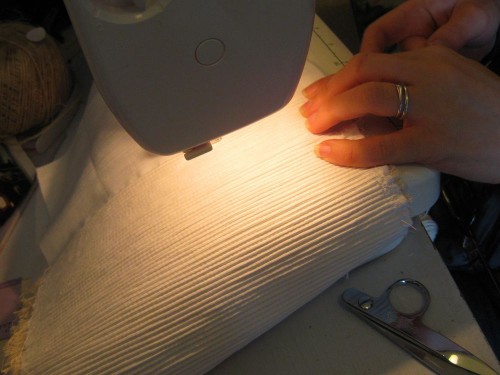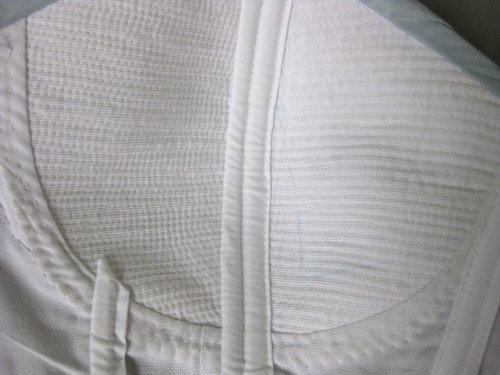While Shell’s dress is a modern wedding dress in most ways, I’m a historical seamstress. So I’m using historical construction techniques to make the dress.
This is most noticeable in the bust. To create the perfect shaping, and to make sure that there would be no chance of nipply weather, no matter how cold the day, I corded the bust panels.
Based on my previous experience with the evilness of cording, I decided to cord full pieces of fabric, and then to cut the bust panels out of those (rather than cording pre-cut panels).
Shell watched me cord the first piece of fabric, and got quite excited about documenting the process.
Felicity got excited about the process too. Felicity loves Shell. She can literally walk all over her.
It was fun letting Felicity get involved. Usually when I sew for clients I lock Felicity out of the room, and she sits outside the French doors and looks sad. But Shell is a good friend, and loves Felicity, so kitty got to sew with me.
Shell got to sew too. After I finished the first cording piece, she sewed the second one, to see how it went. It went well but evil-y. Now she knows what I went through for her dress.
Her cording wasn’t quite as tight and narrow as mine, but that’s not a problem, as the fine cording went on the inner bust panels, and the wider cording balanced out the outsides.
The technique worked beautifully. The shaping on the bust turned out perfect, it provided lots of support, no gaping, and it was even strong enough to withstand running bones across the bust without flattening it.
I used LOTS of bones on the bodice support. There is nothing worse than seeing a bride hiking up her strapless dress!
There are two bones running up the centre front, half bones ending just under the bust at the side-centre front, two bones running over each bust, a bone just at the side of the bust, and a bone on each side of the side seams. Plus, there are double bones at the side-back, and bones on either side of the back fastening.









What a post. It’s so very cool to see the cording in action, but better yet, how using historical techniques solves problems with modern dress.
Now off to pet Muffin, my own calico long-haired furball, who also likes sewing, just because Felicity is so durn cute!
Very best,
Natalie
It looks absolutely amazing! I’ve never tried my hand at cording, nor do I wish to any time soon–it looks like a real pain! By the way, you have very pretty hands!
“nothing worse than seeing a bride hike up her strapless dress” <–This. Yes. This. Agreed completely–and so avoidable with proper tailoring and support! I had never sewn with boning built in before this year–and was amazed by the difference it made! I wouldn't have even needed to wear anything additional (though I did…once you start in on the historic thing, you get in this "the more underthings the better" mentality…). Cording = brilliant idea…must try sometime!
Awesome! This is why I love cording.
Your finishing is so beautiful! The inside of this dress is going to be just as lovely as the outside. And I like the idea of the corded bodice – I may have to think about that for my next formal dress! (I’m a singer… it’s a good excuse for making lots of pretty evening gowns! ;-D )
Thanks for all the details on this. I’ve never heard of using corded fabric like this (I’ve only done some minor Renaissance Faire costuming before) and it is such a great trick to know! Love your pics and the dress is amazing!
Wow. Thanks for the engineering lesson. 🙂
Cording FTW! I’ve fallen in love with cording, despite its evil ways. I’m halfway through my second corset with corded gussets, and the shape and support they provide is fantastic. What kind of cord are you using?
I absolutely love how you’re incorporating historical techniques in such a contemporary gown . Now you’ve got me thinking about using it in modern clothing as well…
What a good friend, and so smart to use cording! If I ever make myself a strapless or halter dress I’ll have to try this technique, evilness notwithstanding.